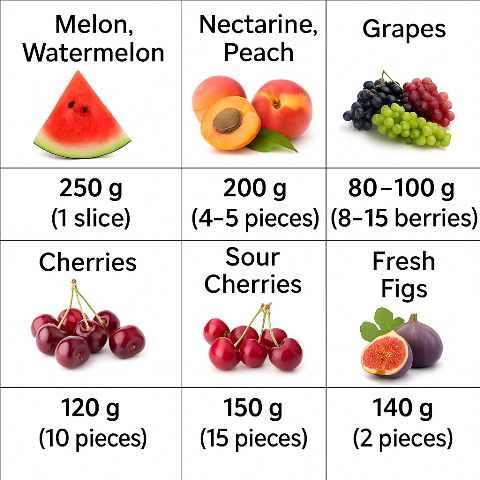Fresh fruit is a food group that entices with its colors and flavors. It represents a recommended source of sugar in the diet because of its favorable nutritional composition and low energy value compared to other desserts (e.g., cakes, pastries, cookies, chocolate, ice cream). Fruit provides the body with water, fiber, vitamins, minerals, and numerous biologically active compounds (phytochemicals), among which vitamins A, C, and E, as well as beta-carotene and lycopene, stand out. All of these are important for protecting the eyes and skin from the sun’s rays and for supporting the immune system, which must fight off numerous potential infections even during the summer months. Although people often consume it in excessive amounts thinking it is “mostly water,” it is important for a person with diabetes to know that summer fruit contains significant amounts of sugar.
Visual estimation using various models or food weighing are methods used to determine the recommended quantity of carbohydrate sources in main meals and snacks. For most patients, one serving is the amount that fits into the volume of a tennis ball (roughly a handful), which corresponds to a portion of fruit containing 15 grams of carbohydrates and defines one carbohydrate unit. Table 1 highlights, in grams, the amount of summer fruit that contains 15 g of carbohydrates.
Table 1: Amount of fruit containing 15 g of carbohydrates

Scientific literature shows a growing body of evidence on the role of plant-based foods and various phytochemicals in the treatment of diabetes and prevention of complications. Their benefits include improving insulin sensitivity, reducing oxidative stress, and regulating blood glucose levels by modulating numerous mechanisms, making them a promising natural complement to traditional therapies for improving metabolic health. In addition to the already mentioned vitamins and compounds with antioxidant and immunomodulatory effects, people with diabetes should pay special attention to adequate intake of magnesium, omega-3 fatty acids, vitamin D, B-group vitamins, chromium, alpha-lipoic acid, and probiotic cultures.
The Standards of Medical Care in Diabetes, revised and published annually by the American Diabetes Association, do not generally recommend dietary supplements as an effective strategy for lowering blood glucose. However, they emphasize that supplementation may be necessary for certain populations, such as pregnant or breastfeeding women, older adults, and individuals following specific diets (vegans) or very low-calorie or low-carbohydrate diets, as well as for those with poor diet quality or confirmed nutrient deficiencies. Improving dietary habits should remain the primary strategy for increasing nutrient levels, focusing on foods that are good sources. If, for valid reasons, supplementation is needed, it must be taken under medical supervision and on a physician’s recommendation.
The most common need for supplementation is vitamin D, as deficiency is widespread worldwide. This unique and very important vitamin can be obtained from foods such as fatty fish (cod, salmon, tuna, sardines), cod liver oil, egg yolk, certain types of mushrooms, beef liver, and fortified products. Vitamin D helps maintain proper calcium and phosphorus levels in the blood, prevents rickets and osteomalacia, plays an important role in regulating and supporting the immune system, and is thought to influence glucose tolerance through its effects on insulin secretion and cellular insulin sensitivity. A common symptom of deficiency is persistent fatigue and muscle pain. Since the primary synthesis occurs in the skin through sunlight exposure, recommended doses are usually reduced or supplementation is paused during summer. Individuals allergic to the sun or those who, for any reason, avoid sun exposure during the summer should pay special attention to maintaining adequate vitamin D levels.
Due to insufficient or irregular consumption of blue fish (sardines, mackerel, tuna) and cold-water fish (salmon, herring), as well as nuts and seeds, supplementation with omega-3 fatty acids is often recommended. Research shows that polyunsaturated omega-3 fatty acids (ALA – alpha-linolenic acid found in plant sources such as flaxseed, chia seeds, and walnuts; EPA – eicosapentaenoic acid; and DHA – docosahexaenoic acid found in fatty fish) support cardiovascular and brain health, help control blood glucose and lipid profiles, and reduce the risk and mortality of cardiovascular disease associated with diabetes. These effects are attributed to antioxidant, anti-inflammatory, lipid-lowering, and antidiabetic mechanisms. As already emphasized, dietary sources of long-chain omega-3 fatty acids should be prioritized, and supplementation considered only when dietary intake is inadequate.
Another problem that occurs more often in summer, due to easier spread of bacteria, viruses, and other parasites, as well as more frequent consumption of food and drinks outside the home and travel to various destinations, is digestive infections. In such situations, alongside dietary adjustments and increased intake of fluids and electrolytes (in cases of vomiting or diarrhea), it is important to support the intestinal microbiota with beneficial probiotic cultures. Research on gut microbiota and its effects on the body is a current topic producing numerous significant scientific insights into how gut composition influences the functioning of other organs and systems, as well as the development and treatment of many conditions, including diabetes. Scientific evidence confirms that probiotic cultures can help regulate blood glucose by reducing low-grade chronic inflammation and oxidative stress, alleviating insulin resistance, increasing beneficial short-chain fatty acids, and modulating the hormone GLP-1, which plays a key role in regulating blood sugar and appetite. Dietary sources of probiotics include fermented foods, notably fermented dairy products and naturally fermented vegetables (e.g., sauerkraut and turnip), which is one reason fermented dairy products are preferred over milk. However, since they contain the milk sugar lactose, serving size must be considered for its effect on blood glucose. It is important to note that food alone often cannot provide sufficient amounts or diversity of beneficial bacteria in specific situations, and supplementation may then be useful.







